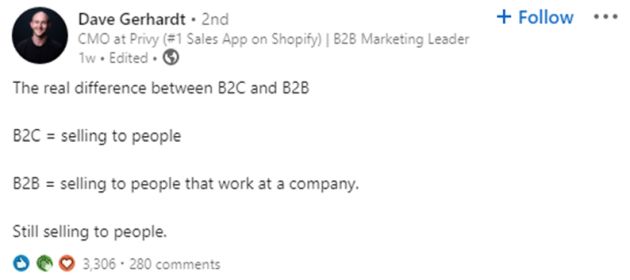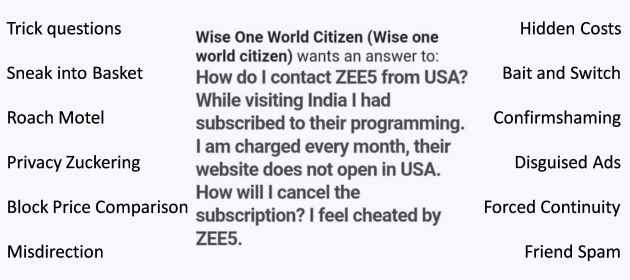We saw a spate of B2C marketers trying to get into B2B six to eight years ago. At the time, I’d shared my thoughts on how to harness emotions in B2B sales in my blog post titled Role Of Emotion In B2B Sales.
Maybe it’s the aftermath of the coronavirus pandemic or whatever but we’re seeing another deluge of B2C marketers trying to pile into B2B and, along with it, a resurgence in the “B2C or B2B, buyers are human beings” narrative.
Take this thread on LinkedIn for example.
Here’s the original post:
Here’s an indicative response:
Completely agree with this! You are always selling to a person who has to make the decision whether the money they are spending will bring them (or their company) a minimum value/return. I feel there needs to be a shift in b2b messaging because a lot of it is just boring corporate buzzwords – don’t just talk about what your product can do for the company, talk about what that product will do for the individual people who use it and how that product solves a problem/issue for those people.
I pointed out that this kind of thinking is too simplistic while selling B2B technology to large enterprises, and advocated what seasoned B2B marketers have known all along:
B2B marketing messaging must be targeted at the Company, its Functions and Strategic Goals rather than end users.
Although it was clear from this guy’s profile that he lacked any B2B marketing experience, I refrained from pointing that out out of courtesy. Meanwhile, he felt free to prolong his flawed line of thinking in his reply:
There are industries that still look for that corporate jargon to be impressed and maybe that is still used as the primary message on most marketing collateral and can be supplemented with a more b2c style message…but I would also counter with this – if customers in the b2c space know when they are being pandered to, I would guess those in top management in the B2B space know as well. They don’t need/want to be told this product will change their life – what will this product do in reality and how does that change impact a problem at scale? Especially today when competition is so high in b2c & b2b (seems like a new project management platform releases everyday!), taking a new approach is essential to standing out.
It became increasingly obvious that this guy is new to B2B marketing because he was recommending an approach that was tried by B2B tech companies in the early days of SAAS:
Focus on the end user, persuade her of your software’s pain-solution proposition, she’ll sign up for your software and expense the $50 or whatever your software costs a month. Once she uses your software, she’ll spread the word around and your software will spread rapidly within her department and eventually throughout the entire company.
Atlassian, GitHub, Slack, Twilio and Zoom are good examples of point solutions providers that followed this so-called Land and Expand strategy at their inception, as highlighted in the Andreessen Horowitz article titled Growth+Sales: The New Era of Enterprise Go-to-Market.
Over time, Land and Expand sparked concerns about the proliferation of so-called “Dark IT”, where the CIO was out of the loop on dozens of applications running in her company. Since the “applications sprawl” was not integrated with the company’s existing IT landscape, it created “islands of automation” and caused untold administrative headaches. Besides, since these point systems were never stress tested against the company’s IT security policy, they became new sources of cyberthreats.
As a result, large enterprises progressively clamped down on vendors’ land-and-expand strategy. In some companies, expensing software on corporate credit card has become a firing offence, as leading VC Ben Horowitz points out in Meet the New Enterprise Customer, He’s a Lot Like the Old Enterprise Customer:
Purchasing anything in a large organization requires a rigorous justification process that generally culminates in a purchase order (PO). They do not allow their employees to use their credit cards to buy technology off of the Internet. In fact, at many companies, doing so and attempting to expense it after the fact is a fire-able offense.
So land-and-expand hasn’t scaled too well except for very niche B2B technologies.
Many B2C marketers, including some of the people on the aforementioned LinkedIn thread, naively assume that a solution for the end user is also a solution for the company.
That’s seldom the case in large enterprises for more reasons than one.
#1. Point Solution Versus Integrated Suite
A finance user is happy with his existing invoicing point software on which he can raise an invoice in one minute.
But point solutions don’t talk to one another. As a result, they don’t provide visibility for the company’s C Suite into lifeblood KPIs like enterprise-wide Revenues and AR and cause many other problems for the company.
(Ironically, what is a good system for the end user can be a bad system for the company.)
ERP remedies this problem by providing a single, unified system across the enterprise such that if you generate an invoice, any decent ERP will automatically post updates in realtime to inventory, AR and GL modules of the integrated suite.
But this elongates the invoice processing time. An invoice that used to take one minute in the point system may take 5-10 minutes on the ERP. This causes pain for the end user in finance without delivering any benefit to him. Can you target him with that message?
I thought so too.
Not surprisingly, ERP and other enterprise applications face a lot of resistance at the grassroot level of most large enterprises.
Nope in most B2B tech.
When I sell an ERP, I'm going to replace a point invoicing system that takes 1 min to generate an invoice with an integrated system that would take 10 min to generate the same invoice.
How can I succeed if I talk to the person behind that invoice?
— Ketharaman Swaminathan (@s_ketharaman) February 20, 2021
You can’t sell such technology to large enterprises by targeting your messaging at the end user.
Marketing collateral must be targeted at corporate and SBU levels. They must use jargon, not just to impress. That’s because jargon gets rid of apathy at the end user level, thus killing the “no decision” problem that’s very common in B2B sales. More in Six Secrets Of Making Jargon Work For You.
#2. Flexibility Versus Rigidity
Flexibility resonates well with end users. But CxOs like to hear about control and best practices.
One of our customers had a tool that helps extensions to be built to its ERP (henceforth “EBT”). By using a drag-and-drop interface, EBT allowed end users to modify existing functionality and develop new functionality without IT’s involvement. End users loved EBT.
Since the product spoke for itself, our customer thought it wasn’t necessary to create marketing messaging around EBT. Big mistake.
When CxOs heard about EBT from their operating level people, they reacted to it very differently. Most of them feared that EBT would be used by every Tom Dick and Harry in their company to subvert the ERP to their own will. Which defeated the purpose of implementing a single product across the entire enterprise and ran counter to their vision of leveraging global best practices to take their company to the next level. As a result, the C Suite of many prospect companies regularly vetoed the purchase of this ERP.
Sadly, what was a big hit with end users proved to be a deal-breaker with decision makers behind the scenes.
When we stepped in, we quickly figured out what was going wrong. We then repositioned EBT as a no-code platform for building competitive advantage. We changed the messaging to “Use EBT to incorporate your competitive advantages into your ERP and gain an unfair advantage in the market.”
This messaging struck a nice chord. It assured the top management of buyer companies that, if they had a competitive advantage, they could use EBT to build it easily; if not, they could adopt best practices. That proved to be a powerful differentiator against competitors who either forced best practices down their throat or allowed unfettered customizations.
#3. People Versus Committees
 Twitter user @Juanpulag echoes the Original Poster on LinkedIn: “You will be in the same table talking with a person that represents a company. Well, he / she is representing the company interests instead him/her personal view, however is a person.”
Twitter user @Juanpulag echoes the Original Poster on LinkedIn: “You will be in the same table talking with a person that represents a company. Well, he / she is representing the company interests instead him/her personal view, however is a person.”
This is one big mistake made by many B2C marketers lacking real world B2B marketing experience.
They fail to realize that you’ll not be talking to one person across the table but a committee of many people drawn from different functions of the company. According to CEB / Gartner, the average buying group size is 5.4 people.
They go on to think simplistically that crafting messages personalized to each of those 5-6 people in the committee will do the trick. In reality, this will take them in the wrong direction.
While committees are made of people, seasoned B2B technology sales leaders know that a committee behaves very differently from any one person on it. Content marketers need to understand group dynamics and craft their messaging accordingly. Sending personalized messages to individuals on the committee will lead to “no decision” at best and losing the deal to your competitor at worst.
If you’re selling to companies where the end user is also the decision maker, it makes sense to target your message to users.
But, in most enterprises, the user is not the buyer. Therefore, your messaging must be targeted at the company and its C Suite.
Not for a moment am I suggesting that your messaging should ignore end users. My point is that user-centric content should be pushed out to a later stage when users are just about to start using the product (in whose purchase they played little or no role). A good place for such comms is Customer Success materials like onboarding workflows and user manuals but not Marketing Collateral.
So far, we’ve talked about messaging at company / SBU versus end user.
Soon we may need to target our marketing messages at machines!
The CMO of MasterCard calls this “Machine-to-Machine Selling”.
'To get into your customer's Initial Consideration Set, you need to sell to their algorithms.' ~ MasterCard CMO @RajaRajamannar.
Years ago, I gave a heads-up to my retainer clients to sell to bots. They're thanking me now!
https://t.co/ynQ1SpdTKC . #Alexa #Shortlist pic.twitter.com/gtbCu1EdoR— Ketharaman Swaminathan (@s_ketharaman) February 11, 2021
I gave a heads-up about this emerging trend to my company’s retainer customers five years ago in my post titled Why Advertisers Must Pay For Ads Seen By Bots.
All current use cases for selling to algorithms revolve around B2C but I won’t be surprised if they extend to B2B in the forseeable future.
RELATED READING:
Use Of Segmentation, Targeting, Positioning In Marketing For B2C and B2B: What’s The Difference?

